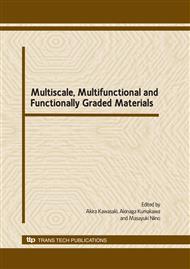p.279
p.287
p.293
p.299
p.305
p.313
p.319
p.327
p.333
Topology Optimized Design of Functionally Graded Piezoelectric Resonators with Specified Resonance Frequencies
Abstract:
This work explores the design of piezoelectric resonators based on functionally graded material (FGM) concept. The goal is to design single-frequency Functionally Graded Piezoelectric Resonators (FGPR) subjected to the following requirements: (i) an assurance of the specified resonance frequency, and (ii) for most acoustic wave generation applications, the FGPR is required to oscillate in the piston mode. Several approaches can be used to achieve these goals; however, a novel approach is to design the piezoelectric transducer by using Topology Optimization Method. Accordingly, in this work, the optimal material gradation of an FGPR is found, which maximizes a specified and single resonance frequency subjected to a volume constraint. To track the desirable piston mode, a mode-tracking method utilizing the modal assurance criterion (MAC) is applied. The continuous change of piezoelectric, dielectric, and elastic properties is achieved by using the graded finite element (GFE) concept, where these material properties are interpolated inside the finite element using interpolation functions. The optimization algorithm is constructed based on sequential linear programming (SLP), and the concept of the Continuum Approximation of Material Distribution (CAMD) is considered. The software is implemented in MATLAB language. In addition, to illustrate the method, a two-dimensional FGPR is designed with plane strain assumption. Performance of designed FGPR is compared with non-FGPR performance.
Info:
Periodical:
Pages:
305-310
Citation:
Online since:
October 2009
Price:
Сopyright:
© 2010 Trans Tech Publications Ltd. All Rights Reserved
Share:
Citation:


